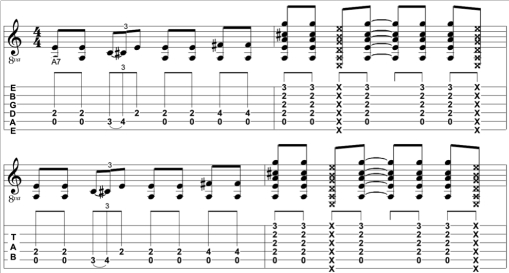A lot of guitarists are at risk of not fully developing their blues rhythm skills because of stopping to learn about what they can do rhythmically with their instrument. They tend to focus more on lead playing and although they might be fluent lead guitarists, their rhythm playing is very limited. They play restricted and often boring blues rhythm parts. This group of guitarists is convinced that there are not many different approaches to bluesy rhythm playing. In the following article you will see that they are not right at all. Let me take you on a journey through the possibilities of blues rhythm guitar playing.
We all know the standard 12 bar blues shuffle. This is what beginner guitar players are taught when they start out. Once you are able to play such riffs, you might think there is nothing challenging about playing blues rhythm guitar.



Take a listen to what that famous standard 12 bar blues sounds like.
I do realize that this is a very standard way of playing rhythm and after a while it becomes really monotonous to play that 12 bar progression over and over again in the same way, right? Nevertheless, you should keep in mind that this standard riff is at the basis of what can be done rhythmically. The general goal is to improve your playing constantly, so you want to know what alternatives there are and how you can make your rhythm playing more interesting, not only for the audience, but also for yourself. All right, let's get down to business and let me show you the first thing you can do.

The illustration shown here resembles a lot like the first illustration I showed you, right? However, we spiced it up with a little, but significant adaptation. Let's take a look what is going on exactly. On the fourth beat of each measure we do a hammer-on from the third to the fourth fret on the A-string and end by hitting the second fret on the D-string. Try it and hear how good it sounds.
Let's check out what else we can do.

Try playing the riff you've just learned and incorporate chords into it. Aren't you starting to sound more interesting than simply playing that standard riff?
It does not matter where you incorporate the chords or the riff you've just learned. Just try switching with it and experiment with it. Here is an example of a complete twelve bar progression with the new techniques applied on:
Let's have a look at some more alternatives by moving up the neck. Don't forget we are still simply playing a twelve bar blues. Try playing the following riff and try to hit the strings really hard to sound even better.

Take a listen at the next fragment to hear some riffs created with the pentatonic scale.
This type of playing is already a bit more difficult and it takes some time to get used to. If you have never tried playing this type of riffs before, it might seem it is a bit too much for now. However, if they are a bit problematic to you, try playing them at a slower pace. If you play it slower, it will be easier to become familiar with playing these riffs. The next illustration show the riff played slower. You might say it the tempo is divided in two. So you can take one measure for the first part and one measure for the second part.

Once you're able two play the riff at this slower pace, try playing it faster. These riffs might be challenging for now, but the good news is that there are practice approaches that are specifically designed for mastering this type of rhythm playing. More about this in a future article.
You must have heard at least one time in your life that rock is a child of the blues. It is only when you have the knowledge about how blues and rock relate that you can really feel it.
Finally, here is an example where blues and rock are mixed. You recognize the blues riff in one measure, but in the next there is this really cool sounding piece of rock.

Check out here how that riff sounds.
Of course this is only the tip of the iceberg and that is exactly why I developed a completely free eBook with all the information for you to learn all about improving your blues rhythm playing.
One last thing I want to say is that you should always have in mind that we are talking about music. Make sure you dive into a pool of blues music, because listening to blues will get you more of a feel for this type of music. I cannot underline in any way how crucial it is to listen to blues music.
Born in Belguim, Antony Reynaert learned to play classical piano at the age of seven. At the age of 17, got intensely into guitar, practicing for more than five hours a day.
He now devotes his time into building a successful career in music, giving guitar lessons and workshops on both a national and international level.